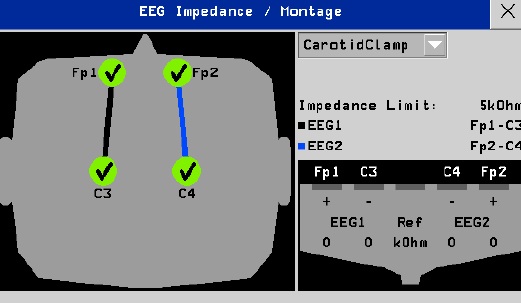Non-invasive neuromonitoring in intensive care units in Colombia
Abstract
Continuous non-invasive electroencephalographic monitoring is an essential technique for critical care patients as it shows directly and indirectly the patient’s brain activity and makes it possible to relate it with findings in the clinical status. It is highly sensitive, although its specificity is lower, so they can show alterations of the state of consciousness without clarifying the etiology.
Continuous electroencephalographic recording in patients with altered levels of consciousness, seizures, and convulsive and non-convulsive status epilepticus has been increasing in recent years as real-time feedback of the cerebral function shows evolution changes and allows for the identification of electric and subclinical epileptic seizures that are highly important since they do not have clinical correlations.
These findings in electroencephalographic monitoring also help to modify pharmacological and antiseizure treatments. For practitioners, they are advantageous when making timely decisions that impact the prognosis of the patient.
Downloads
References
Abend N, Chapman K, Gallentine W, Goldstein J, Hyslop A, Loddenkemper T, et al. Electroencephalographic monitoring in the pediatric intensive care unit. Curr Neurol Neurosci Rep. 2013;13:330. https://doi.org/10.1007/s11910-012-0330-3
Sánchez S, Carpenter J, Chapman K, Dlugos D, Gallentine W, Giza C, et al. Pediatric ICU EEG monitoring: Current resources and practice in the United States and Canada. J Clin Neurophysiol. 2013;30:156-60. https://doi.org/10.1097/WNP.0b013e31827eda27
Punjasawadwong Y, Phongchiewboon A, Bunchungmongkol N. Bispectral index for improving anaesthetic delivery and postoperative recovery. Cochrane Database Syst Rev. 2014;2014:CD003843. https://doi.org/10.1002/14651858
Hernández-Hernández M, Iglesias-Posadilla D, Ruiz-Ruiz A, Gómez-Marcos V, Fernández-Torre J. Matriz de densidad espectral de color del BIS bilateral en estado epiléptico. An Pediatr (Barc). 2016;85:44-47. https://doi.org/10.1016/j.anpedi.2015.09.021
Hernández-Hernández M, Fernández-Torre J, Ruiz-Ruiz A, Iglesias-Posadilla D, Gómez-Marcos V, Holanda-Peña M. Utilidad de la matriz de densidad espectral del sistema de índice biespectral bilateral en la monitorización del status epilepticus no convulsivo. Medicina Intensiva. 2014;38:265-7. https://doi.org/10.1016/j.medin.2013.01.01
Glass H, Wusthoff C, Shellhaas R. Amplitude-integrated electroencephalography. J Child Neurol. 2013;28:1342-50. https://doi.org/10.1177/0883073813488663
Buttle S, Lemyre B, Sell E, Redpath S, Bulusu S, Webster R, et al. Combined conventional and amplitude-integrated EEG monitoring in neonates: A prospective study. J Child Neurol. 2019;34:313-20. https://doi.org/10.1177/0883073819829256
Ranucci M, Isgrò G, De La Torre T, Romitti F, Conti D, Carlucci C. Near-infrared spectroscopy correlates with continuous superior vena cava oxygen saturation in pediatric cardiac surgery patients. Paediatr Anaesth. 2008;18:1163-9. https://doi.org/10.1111/j.1460-9592.2008.02783.x
Murkin J, Arango M. Near-infrared spectroscopy as an index of brain and tissue oxygenation. Br J Anaesth. 2009;103:i3-13. https://doi.org/10.1093/bja/aep299
Rasulo FA, Bertuetti RJ. Transcranial doppler and optic nerve sonography. Cardiothorac Vasc Anesth. 2019;33(Suppl.1):S38-S52. https://doi.org/10.1053/j.jvca.2019.03.040
Matta B, Czosnyka M. Transcranial Doppler ultrasonography in anesthesia and neurosurgery. In: Cotrell JE, Patel P, editors. Cottrell and Patel’s Neuroanesthesia. 6th edition. Philadelphia, PA: Elsevier; 2017.
Rasulo FA, Bertuetti R, Robba C, Lusenti F, Cantoni A, Bernini M. The accuracy of transcranial Doppler in excluding intracranial hypertension following acute brain injury: A multicenter prospective pilot study. Crit Care. 2017;21:44. https://doi.org/10.1186/s13054-017-1632-2
Brzan-Simenc G, Ambrozic J, Prokselj K, Tul N, Cvijic M, Mirkovic T, et al. Ocular ultrasonography for diagnosing increased intracranial pressure in patients with severe preeclampsia. Int J Obstet Anesth. 2018;36:49‑55. https://doi.org/10.1016/j.ijoa.2018.06.005
Aaslid R, Markwalder TM, Nornes H. Noninvasive transcranial Doppler ultrasound recording of flow velocity in basal cerebral arteries. J Neurosurg. 1982;57:769-74. https://doi.org/10.1515/9783110847000-032
Bellner, J Romner B, Reinstrup P, Kristiansson KA, Ryding E, Brandt L. Transcranial Doppler sonography pulsatility index (PI) reflects intracranial pressure (ICP). Surg Neurol. 2004;62:45-51. https://doi.org/10.1016/j.surneu.2003.12.007
Some similar items:
- José Alejandro Martínez-Ibarra, Jorge Alejandro Martínez-Grant, Miguel Roberto Verdugo-Cervantes, Rafael Bustos-Saldaña, Benjamín Nogueda-Torres, Monitoring triatomid bug (Hemiptera: Reduviidae) presence by sentinel chicken coops in Southern Jalisco State, México , Biomedica: Vol. 30 No. 1 (2010)
- Herbert García, Gustavo Andrés Salguero, Jeffer Moreno, Clara Arteaga, Alejandro Giraldo, Frequency of congenital anomalies at the Instituto Materno Infantil, Bogota, Colombia. , Biomedica: Vol. 23 No. 2 (2003)
- Argemiro Fragozo, María Fernanda Puerta, Juan Diego Misas, Comparative analysis of insulin glargine vs. insulin detemir: A cost-minimization study applicable to Colombia , Biomedica: Vol. 35 No. 2 (2015)
- Marcela Hernández, Gabriel Tribiño, Carlos Bustamante, Characterization of potential drug-drug interactions in patients hospitalized in the intensive care unit of a tertiary hospital in Bogotá , Biomedica: Vol. 38 No. 3 (2018)
- Freddy Israel Pantoja, Willinton Robert Ricaurte , Diana Elizabeth Rosero , Relationship between death and admission of pediatric patients to intensive care due to Staphylococcus aureus bacteremia acquired in the community, 2014-2017 , Biomedica: Vol. 41 No. 1 (2021)

| Article metrics | |
|---|---|
| Abstract views | |
| Galley vies | |
| PDF Views | |
| HTML views | |
| Other views | |

























